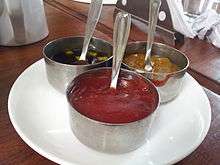Cheong (food)
.jpg) a jar of yuja-cheong | |
| Place of origin | Korea |
|---|---|
| Associated national cuisine | Korean cuisine |
| Similar dishes | syrup, fruit preserve, marmalade |
| Korean name | |
| Hangul | 청 |
|---|---|
| Hanja | 淸 |
| Revised Romanization | cheong |
| McCune–Reischauer | ch'ŏng |
| IPA | [tɕʰʌŋ] |
Cheong (청; 淸) is a name for various sweetened foods in the form of syrups, marmalades, and fruit preserves. In Korean cuisine, cheong is used as a tea base, as a honey-or-sugar-substitute in cooking, as a condiment, and also as an alternative medicine to treat the common cold and other minor illnesses.[1][2][3]
Originally, the word cheong (청; 淸) was used to refer to honey in Korean royal court cuisine.[4] The name jocheong (조청; 造淸; "crafted honey") was given to mullyeot (liquid-form yeot) and other human-made honey-substitutes.[5][6] Now, honey is rarely called cheong in Korean, but is instead called kkul (꿀), which is the native (non-Sino-Korean) name for honey. The name kkul was used in the past, outside the royal court.
Varieties
- Jocheong (조청; "crafted honey")
- mullyeot (물엿; liquid yeot) or rice syrup
- corn syrup
- Maesil-cheong (매실청; "plum syrup")
- Mogwa-cheong (모과청; quince preserve)
- Mucheong (무청; radish syrup)
- Yuja-cheong (유자청; yuja marmalade)
See also
References
- ↑ Ro, Hyo Sun (1 February 2017). "Home cooking for Korean food: Sataejjim (slow cooker braised beef shank)". The Straits Times. Retrieved 7 February 2017.
- ↑ Baek, Jong-hyun (23 April 2016). "A taste of Korea with three regional delights". Korea JoongAng Daily. Retrieved 7 February 2017.
- ↑ 배, 수빈 (10 December 2016). "[지금이 제철] 추울 때 진가 발휘하는 '청(淸)'". MBC News Today (in Korean). Retrieved 7 February 2017.
- ↑ "cheong" 청. Standard Korean Language Dictionary (in Korean). National Institute of Korean Language. Retrieved 17 February 2017.
- ↑ "jocheong" 조청. Standard Korean Language Dictionary (in Korean). National Institute of Korean Language. Retrieved 17 February 2017.
- ↑ "mullyeot" 물엿. Standard Korean Language Dictionary (in Korean). National Institute of Korean Language. Retrieved 17 February 2017.
External links

This article is issued from
Wikipedia.
The text is licensed under Creative Commons - Attribution - Sharealike.
Additional terms may apply for the media files.

